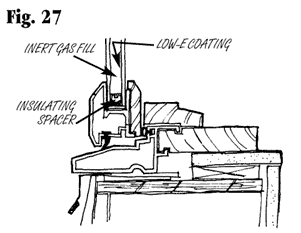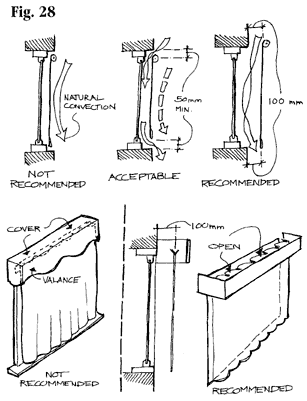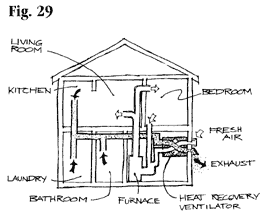Consumer's Guide – To buying Energy-Efficient Windows and Doors
Catalogue No.: M-92-156/2001E
ISBN: 0-662-27162-9
Section 5 –
Condensation and Windows
5.1 What is Condensation?
The occupants of a house rightly feel that condensation on the inside surfaces of windows is not good. They immediately think of obstructed visibility, reduction of the intensity of natural lighting and, above all, deterioration of interior finishes (rings, stains, peeling paint) and mould.
Superficial condensation occurs when the surface temperature of a solid (glass, sash, frame) is lower than the dew point of the humid air in its immediate vicinity. The moisture, naturally present in the air in the form of vapour, changes into liquid water on contact with these cold surfaces. The resulting droplets form a film of water and run down the glass when the condensation is heavy or does not evaporate fast enough. In the case of windows, condensation will often occur at the edge of the glazing because of conduction through the spacer and air convection within the glazing cavity. Such condensation can be decreased or eliminated by raising the inside surface temperature and/or decreasing the relative humidity of the indoor air.
5.2 Prevention Techniques
Reducing or eliminating condensation often means using several complementary techniques. These techniques concern the window itself, the method of installation, the interior window accessories (curtains, blinds, valances), the arrangement of heat sources (hot air registers, baseboard heating, convection heaters) and the relative humidity of the indoor air. The overall condensation resistance of a window depends on each of these factors.
5.3 Condensation Resistance of Windows
 Several techniques are used by manufacturers to increase the condensation resistance of windows. These include windows filled with a convection-limiting inert gas, low-emissivity coatings that increase the temperature of the glass, insulating spacers that reduce heat conduction, and non-conducting sashes and frames (Fig. 27).
Several techniques are used by manufacturers to increase the condensation resistance of windows. These include windows filled with a convection-limiting inert gas, low-emissivity coatings that increase the temperature of the glass, insulating spacers that reduce heat conduction, and non-conducting sashes and frames (Fig. 27).
Energy-efficient windows are least likely to have condensation. Their resistance to condensation, however, depends on the indoor humidity level. A humidity level of more than 40 percent, when the outside temperature is -20°C or colder, may cause condensation even on a good performing window.
5.4 Window Installation
To minimize condensation on windows, follow these guidelines during installation:
position the window as close as possible to the interior finish;
insulate the space between the window frame and the rough opening around the perimeter of the window; and
seal the joint between the frame and the rough opening on the interior side.
5.5 Interior Window Accessories
 To maintain the condensation resistance of the window, interior window accessories such as curtains, blinds and valances must not inhibit or impede the movement of air at the surface of the window. Any restriction of air movement will reduce the condensation resistance and thus increase "sweating" on the window. Figure 28 illustrates installation techniques that are recommended, acceptable or not recommended.
To maintain the condensation resistance of the window, interior window accessories such as curtains, blinds and valances must not inhibit or impede the movement of air at the surface of the window. Any restriction of air movement will reduce the condensation resistance and thus increase "sweating" on the window. Figure 28 illustrates installation techniques that are recommended, acceptable or not recommended.
5.6 Arrangement of Heat Sources
Although energy-efficient windows are now available, the heat loss through them is still greater than through the adjacent walls. This is why windows with heat sources located below them are less prone to condensation. When the heating system is in operation, the air temperature will be higher in the vicinity of the window than in the centre of the room, resulting in increased condensation resistance. Care must nevertheless be taken to ensure that the hot air from the registers does not flow directly onto the interior surface of the glass, as this could give rise to thermal stress problems in the glazed unit that could cause the glass to break.
5.7 Controlling the Relative Humidity of Indoor Air
Replacing old windows with new, more efficient ones generally results in a significant improvement in the airtightness of the building enclosure, and thus substantial energy savings and improved comfort for the occupants.
However, when living habits and the production of humidity in the house (showers, baths, cooking activities, plants, etc.) remain unchanged, and there is a significant reduction in the rate of air exchange, the resulting relative humidity at certain times of the winter may become excessive and cause condensation on the inside surface of new windows.
Reducing the amount of humidity in the house may enable you to limit or eliminate the problems caused by humidity. Some simple but effective measures can be applied.
If your heating system is fitted with a humidifier, or if you use portable humidifiers, disconnect them.
Avoid hanging laundry inside to dry, and make sure that the exhaust from the clothes dryer is vented outside.
If you have a crawl space under your house, cover the beaten earth with 0.15 mm (6 mil) polyethylene. The crawl space may have to be ventilated during the summer.
Make sure that your basement is well drained and protected against excess moisture. Also, make sure that gutters and the slope of the land around the house drain water away from the house.
Try not to produce too much humidity. Plants, laundry, showers and cooking without lids are major sources of water vapour.
Avoid drying firewood in the house. A cord of wood can release more than 270 litres (60 gallons) of water.
If the signs of excessive humidity persist, you should increase the ventilation of your house. When the frequency of condensation is low (once or twice during winter), you can reduce or eliminate the problem by briefly opening two windows located on opposite walls or by turning on the kitchen or bathroom exhaust fan. If the frequency of condensation is unacceptable, you should install a controlled mechanical ventilation system (Fig. 29). Systems incorporating a heat recovery unit and a relative humidity control should be preferred.

Previous Section |
Next Section
| 


